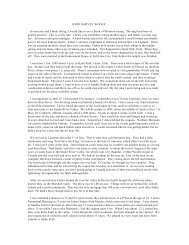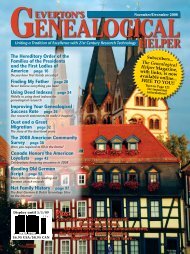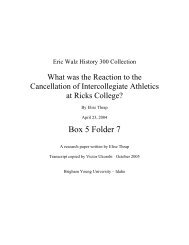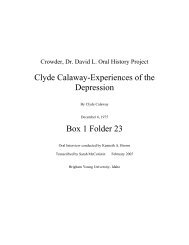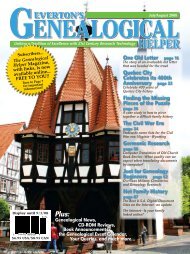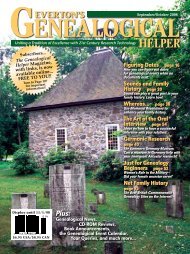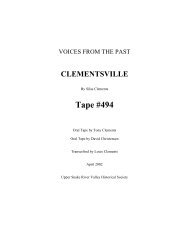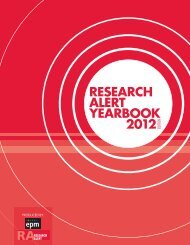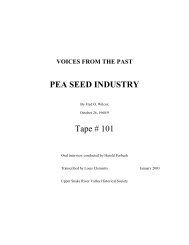HelPeR - BYU Idaho Special Collections and Family History
HelPeR - BYU Idaho Special Collections and Family History
HelPeR - BYU Idaho Special Collections and Family History
You also want an ePaper? Increase the reach of your titles
YUMPU automatically turns print PDFs into web optimized ePapers that Google loves.
Germanic Research QUESTIONS ANSWERED<br />
Using German<br />
Parish Records<br />
By Ga i l Bl a n k e n a u<br />
A large number of Americans who engage in family<br />
history research have at least one German ancestor.<br />
For those with Pennsylvania German ancestry,<br />
American records start mainly in the 1700s. Yet, the<br />
largest group of Germans immigrated to the United<br />
States from 1840 to 1900, so it doesn’t take long for<br />
researchers to jump back to the “mother country.” For<br />
these relatively recent groups, German parish records<br />
can be a veritable gold mine for family historians.<br />
Many of them are available on microfilm through<br />
<strong>Family</strong> <strong>History</strong> Centers across the country.<br />
As always in genealogy, the real-estate mantra “location,<br />
location, location,” applies here. In the case<br />
of my husb<strong>and</strong>’s family, my mother-in-law supplied<br />
the names of the ancestral villages using old funeral<br />
cards that were in her possession.<br />
I first used the familysearch.org database to find<br />
out which churches might have been the home parish<br />
for these people. For example, I knew that one<br />
ancestor was Anton Lienen, <strong>and</strong> that he was from<br />
Westphalia. The International Genealogical Index<br />
(IGI) showed Anton Lienen, son of Friedr. Lienen <strong>and</strong><br />
Christina Siweke was christened 19 May 1871, as a<br />
Roman Catholic, Roemisch-Katholisch, Stuken Brock,<br />
Westfalen, Preussen. This matched the birthdate <strong>and</strong><br />
place that my mother-in-law had given me. I then<br />
ordered the parish records for Stukenbrock parish<br />
<strong>and</strong> the fun began.<br />
Working in German<br />
There is a limited vocabulary needed for research—<br />
obviously words like “birth,” “marriage,” <strong>and</strong> “death.”<br />
The further back you go, the more likely you are to encounter<br />
Latin as well. With a dictionary, it is relatively<br />
easy to figure out what the records say. A good list of<br />
German genealogy-related words is on the familysearch.<br />
org website under the tab “Research Guidance.”<br />
The most difficult part of German research is reading<br />
the h<strong>and</strong>writing <strong>and</strong>/or the quality of the microfilm.<br />
Some recorders had a fine clear h<strong>and</strong>, <strong>and</strong><br />
others did not. The more recent records are in modern<br />
script, but the further back you progress, you will<br />
encounter the dreaded German script. A good chart<br />
for interpreting German script can be found on the<br />
Yale website: http://www.library.yale.edu/cataloging/music/fraktur.htm.<br />
As with English records, you need to learn the idiosyncrasies<br />
of the writer. Notice how the clerk wrote<br />
the “E” or the “F” somewhere else on the page <strong>and</strong><br />
make yourself a note.<br />
Always copy the siblings’ records as well—a<br />
good practice for any genealogical problem. There<br />
are sometimes little differences <strong>and</strong> usages that will<br />
give you the clue to break through to the next generation.<br />
Parents die, the widow remarries, all this<br />
needs to be noted. For example, in one ancestral record,<br />
the mother was Marg. Weimans, for the brother,<br />
the mother was called Marg. Weggemans.<br />
Instead of original parish records, many researchers<br />
choose to order the “Kirchenbuch Duplikat.”<br />
These are transcriptions of the records for a parish.<br />
Obviously, this is easier to use, as someone else has<br />
already done the hard work of reading the h<strong>and</strong>writing.<br />
However, this is not considered as reliable.<br />
Transcription errors happen. In addition, most of<br />
these books stop around 1800 to 1815. To go back<br />
further, you’ll need those original records after all.<br />
You may want to use them in t<strong>and</strong>em, starting with<br />
the easy-to-read Duplikat, then confirming the information<br />
<strong>and</strong> working beyond them in the original<br />
records.<br />
The Research—A Case Study<br />
Consider the birth <strong>and</strong> christening record for Anton<br />
Lienen of Stukenbroeck parish in Westphalia, Germany.<br />
At the top is the title, “Geborne und Getaufte<br />
im Jahre 1871.” This means “Born <strong>and</strong> Baptized in the<br />
year 1871”(See Figure 1). The facing page continues<br />
the title, “im Monat,” meaning “in the month of,”<br />
followed by the page number (See Figure 2).<br />
On p. 151 of the births <strong>and</strong> baptisms, the record is<br />
in columns. Column one is the Taufname—Christening<br />
name. Next is the Tag (Day) <strong>and</strong> Stunde (hour)<br />
of the (Geburt) Birth. Vor und Zunammen und St<strong>and</strong><br />
des Vaters (first <strong>and</strong> last name <strong>and</strong> occupation of the<br />
father).<br />
On the facing page is the same information for the<br />
mother (See Figure 2). “Wohnort” is the residence of<br />
the parents, followed by the day of the christening<br />
(which is usually one or two days after the birth).<br />
Next, is the name of the Pastor <strong>and</strong> last is the name<br />
of the godparents.<br />
42 © Ev e r t o n’s Ge n e a l o g i c a l He l p e r Ja n ua ry/Fe b r u a r y 2009



